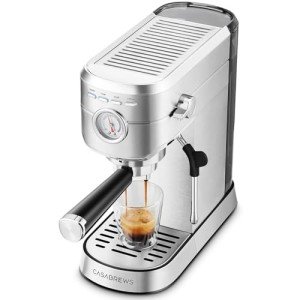Home Use Espresso Machines: A Comprehensive Guide
Espresso machines have become a staple in numerous homes as coffee enthusiasts seek to reproduce café-quality brews in the convenience of their kitchens. The rise in popularity has actually resulted in a diverse market filled with numerous designs, functions, and rates. This post intends to supply a useful summary of home use espresso machines, helping readers navigate their options efficiently.
Understanding Espresso Machines
Espresso machines work by forcing hot water through finely-ground coffee under high pressure, leading to a concentrated coffee beverage called espresso. There are several types of espresso machines classified based on their developing techniques and level of automation. The most common types consist of:
- Manual Espresso Machines: These need the user to manage the pressure and water circulation, enabling a more hands-on coffee-making experience.
- Semi-Automatic Espresso Machines: These provide automatic control over water pressure, while the user by hand grinds and tamps the coffee.
- Automatic Espresso Machines: With the push of a button, these machines instantly manage the circulation of water, making it much easier to brew espresso with consistent results.
- Super-Automatic Espresso Machines: These all-in-one machines manage grinding, tampering, brewing, and even milk frothing, making them ideal for users searching for benefit.
- Capsule or Pod Machines: These use pre-packaged coffee pods to produce espresso with minimal effort, however they restrict option in brewing methods and flavors.
Table: Comparison of Espresso Machine Types
| Type | Control Level | Ease of Use | Cleaning Level | Ideal For |
|---|---|---|---|---|
| Manual | User-controlled | Moderate | High | Coffee purists |
| Semi-Automatic | Partial automation | Moderate | Moderate | Home baristas |
| Automatic | Completely automated | Easy | Low | Hectic people |
| Super-Automatic | Totally automated | Really easy | Extremely low | Convenience applicants |
| Capsule/Pod | Fully automated | Extremely simple | Extremely low | Casual drinkers |
Key Features to Consider
When picking a home use espresso machine, it's important to consider various functions that can significantly impact the quality of espresso and user experience.
- Pressure: Look for machines that supply at least 9 bars of pressure, as this is considered optimum for brewing espresso.
- Boiler Systems: Single vs. dual boiler systems identify temperature level stability and the capability to brew espresso and steam milk simultaneously.
- Grinder: Integrated grinders permit newly ground coffee, which improves taste. Think about Buy Espresso Online with adjustable grind settings.
- Milk Frother: For those who take pleasure in cappuccinos and lattes, a built-in steam wand or automatic frother is important.
- Size and Design: Consider your kitchen area area and aesthetic preferences. Machines are available in numerous sizes, from compact to large setups.
- Cost: Home espresso machines can vary from a few hundred to numerous thousand dollars, so it's essential to establish a budget before checking out choices.
Advantages and disadvantages of Home Use Espresso Machines
| Pros | Cons |
|---|---|
| Benefit of brewing coffee at home | Preliminary financial investment can be high |
| Quality of espresso is often superior | Requires some ability, particularly with manual machines |
| Ability to explore flavors | Maintenance and cleansing can be labor-intensive |
| Can conserve cash in the long run | Not all machines will match every coffee choice |
Maintenance and Cleaning Tips
Maintaining an espresso machine is essential for extending its life and making sure constant brew quality. Here are some beneficial ideas:
- Regular Descaling: Minerals from water can construct up in the machine. Descale every 1-3 months, depending on water solidity.
- Daily Cleaning: Rinse portafilters, baskets, and steam wands after each use to avoid coffee oils from building residue.
- Use Filtered Water: This can help lower mineral buildup and improve the taste of coffee.
- Change Gaskets and Seals: These components might break gradually and needs to be changed to preserve pressure and performance.
- Check out the Manual: Each machine has specific care instructions; following these will make sure longevity.
Frequently Asked Questions About Home Use Espresso Machines
Q1: What is the best budget espresso machine?The best budget espresso machine typically depends upon specific needs, however models like the DeLonghi EC155 or the Breville Bambino are popular among users for providing great worth. Q2: How long do home espresso machines usually last?With appropriate maintenance, home espresso machines can last anywhere from 5 to 15 years, depending upon the quality of the machine and frequency of use. Q3: Can I make cappuccinos and lattes with any espresso machine?While most espresso machines can make cappuccinos and lattes, having a reliable
steam wand or frother is essential for achieving the ideal milk texture.
Q4: Are super-automatic machines worth the investment?For those who focus on benefit and quick developing, super-automatic machines can be worth the investment, though they may lack some customizability in brew strength and taste. Q5: What types of coffee beans are best for espresso?While individual choice contributes, beans identified as" espresso "blends are typically roasted darker, creating rich flavors and a creamy texture when brewed.
Purchasing a home espresso machine can change the everyday coffee regimen into something special, raising home brews to café quality. By understanding the various kinds of machines, crucial features to consider, maintenance needs, and weighing the
benefits and drawbacks, consumers can make educated choices that fit their individual preferences. As the espresso culture continues to grow, no matter the option, every brew can be a tasty experience waiting to be savored.

